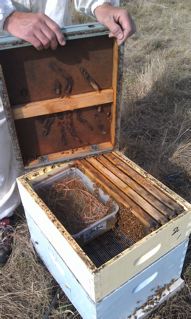This has been a miserable year for bees in the Canberra region; by the end of November there was virtually nothing for the poor little creatures to feed on. In situations like this, you may find it necessary to feed them, and the best time to do this is late summer or autumn, up until about ANZAC Day. If you wait too long or don’t feed them enough, you may lose them, either now or through the winter. When the temperatures start to drop, it’s difficult to get them to feed at all (see Winter Feeding in the Canberra Climate).
Bees need honey and pollen to stay alive and provide food for their babies. In desperate times, the honey can be replaced by syrup made from white sugar. If it offends anyone’s sensibilities to feed their bees sugar, they just need to get over it, make the syrup and save their hives. It won’t make them bludgers. They do need pollen as well, but this shouldn’t be a problem because the extra sugar will give them more energy to find pollen which is usually available from ground flora and such.
Beekeepers will tell you that bees do better on sugar than they do on their own honey. There are some who will even harvest all of the honey about March/April and then feed their bees sugar to build up stores for the winter. In spring, the bees have a preference for the sugar, and will eat it up before they start eating their own honey.
To make the syrup, dissolve 3kg white sugar in 2 litres of water. You’ll need to bring the solution to a boil to get the sugar to dissolve. Don’t feed them brown sugar, raw sugar or honey.
You’ll be surprised how much they eat. An established hive can consume/store about 3 kg of white sugar (in the form of syrup) per hive per week! Sugar’s quite inexpensive and this is a small price to pay to save the hive.
Consistency is the most important consideration in feeding your hive. The first time you feed a starving hive, they will eat most of what you give them, but what you want them to do is to start storing it. The way to do this is to give them a constant supply of syrup. If you stop and start, they just end up eating whatever you give them and never really get ahead.
The first two pictures above are from friend in Murrumbateman who got his hive as a four-frame nucleus about the end of November, and this photo was taken 8 weeks later. They have completely filled the brood box and an ideal super with fat frames of “honey”. The only thing he used to feed them was a Boardman feeder, which he kept refilling whenever it was emptied. He says he never left the jar empty for more than a few hours. Boardman feeders are good for this because you can always see when the jar is empty. He could stop feeding them now (1 February), and his colony will have no trouble getting through the winter. This is what consistency will do.
If it’s not convenient to refill a glass jar every day, you could try another method. I use a 5-litre plastic food storage container (which you can get from Go-Low or similar place like that). The container is placed on top of the frames, inside an empty box. The syrup needs to be inside the hive, otherwise you’ll be feeding every bee within 5 kms, and it’s a good way to spread disease. Fill the container with syrup and place a hand full of pine needles in the syrup. The needles will float and provide a way for the bees to climb out of the syrup. They can swim, but not forever, and they’ll drown if they can’t get out. The container is refilled with 5 litres of syrup every week. With any luck, these colonies will survive the winter, and will repay me next year with an abundant supply of honey.




 Like us on Facebook
Like us on Facebook